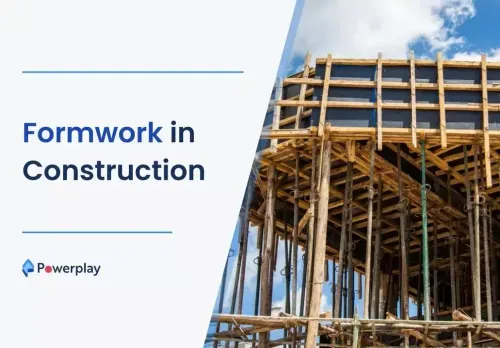Formwork in Construction
-
Kumar Abhishek Anand
- October 12, 2023

Formwork is an essential constituent of the construction industry that can be considered to be indispensable for any kind of construction project small or large. Formwork is also commonly known as shuttering in the construction industry and can also be considered to be ancillary construction where made-up sections called forms or shutters are assembled together. They are mostly temporary structures into which concrete is poured to give the desired shape and size to the project structures. In simple terms formworks are molds that cast concrete in various shapes and sizes. Different types of formwork have been used for hundreds and thousands of years to support building structures for all sizes and shapes until the mortar that has been used solidifies and attains its initial strength. Construction has undeniably been the foundation of present civilization and formworks have played a vital role in the development of construction techniques and practices.

The cost of installing formwork for pouring concrete ranges from 20- 25% of the total cost of construction which can be greater than that for bridges. To save money on formworks, it becomes essential to design and manage economical types of formwork in the early stages itself. After the concrete has achieved its initial strength after solidifying, the formwork is removed which is commonly known as stripping of forms.
Table of Contents
ToggleTypes of Formwork in Construction
Different types of form used in formwork can be constructed from different materials such as wood, steel, aluminum, plastic and plywood. Formworks can also be classified with names of structural members such as formwork for columns known as column formwork, slab formwork, beam formwork. Adequate time and effort are required for setting up forms so that it is strong enough to bear the loads acting on them at any point in time. The types of formworks commonly used in the construction industry are:
1. Formwork based on Type of Material
a. Timber Formwork

One of the first and most common types of material used for formwork in the construction industry was timber. It is extensively used because it has better flexibility than its counterparts and is usually fabricated and assembled on-site as per the required specifications of shape and size. It can be used for most construction projects as it is cheap and easily workable but is a bit more time-consuming and has a shorter lifespan. The timber used for construction formwork should be well seasoned, lightweight, free from loose knots, have a smooth and even surface that comes in contact with the concrete pour. Some of the advantages and disadvantages of using timber for formwork are:
Advantages
- Timber can be cut and carved into any desired shape and size comfortably.
- Since the lightweight timber is suitable for formworks, it can be easily handled.
- Since the timber also provides good thermal resistance it prevents the concrete from being damaged in colder weather or regions.
- Construction is easy when timber formwork is used because it does not require skilled labor to work with.
Disadvantages
- Sometimes if the timber becomes overly dry, it can absorb water from the concrete pour which results in a reduction of concrete strength.
- Timber formworks can only be used for a maximum of 6-7 times.
- Sometimes if the timber contains more water content than required(>20%), the wet concrete may shrink and cause leakage of the slurry.
b. Plywood Formwork

The plywood used for formwork in construction is of Boiling Waterproof(BWP) grade which has been treated with preservatives and is especially suitable in formwork for sheathing, decking and form linings. It is quite economical from the fact that it can be repeatedly used many times if proper care is taken while erecting and dismantling them. One of the most advantageous features of plywood formwork is that it is impressively durable under alternate wetting and dry weather conditions. Plywood formwork has quite a hard surface and can thus withstand massive concrete loads and forces from the concrete mix and compacting vibrations. It is usually used along with timber and comes in numerous sizes and thicknesses. Some of the advantages of using plywood formwork are as follows:
Advantages
- Plywood can be comfortably cut to the appropriate scale requirements.
- Plywood has impressive features such as sturdy, robust and lightweight.
- Plywood improves the appearance and finish of formwork that makes it look smoother and simpler.
- Plywood can offer a flat surface finish to the concrete.
- Plywood can be used more number of times than timber
c. Steel Formwork

Steel formwork is popular nowadays due to its durability and longer life span compared to timber or plywood due to which it can be reused multiple times for a long time. Panels fabricated from steel plates are used to make steel formwork which can be fixed together using appropriate clamps, nuts and bolts. Steel formwork can be made into several shapes or sizes but mostly they are shaped into a circular or curved structure. Even if it is costly than other formwork materials it is useful either in situations where it can be used for multiple projects and there are more than enough chances of it being reused several times or in large-scale projects. The following are some of the advantages and disadvantages of using steel formwork:
Advantages
- Steel panel formwork is sturdier, durable and has a longer lifespan than the above mentioned materials.
- Steel panel formwork can be erected and dismantled much more rapidly than its counterparts.
- Steel panel formwork is cost-effective for large-scale projects or when it can be used for multiple projects for quite a long time.
- Steel panel formwork does not pose any unnecessary problems to the concrete while curing since they do not absorb water and do not shrink or warp.
- Steel panel formwork produces a high quality concrete surface that is smooth and does not require any finishing treatment.
Disadvantages
- Steel panel formwork is costlier than plywood or timber formwork.
- Since steel panel formworks are quite heavy they have to be lifted and erected or dismantled using heavy machinery.
- Steel panel formwork can only be available in a limited number of shapes and sizes.
d. Aluminum Formwork

Aluminum formwork is quite similar to steel formworks, the only major difference being a lower density of aluminum than steel that results in lighter formwork. Before choosing aluminum for formwork it must be known that aluminum has lower strength than steel. Aluminum formwork is quite economical if they have to be reused for a much larger number of times. Aluminum formwork has its own set of advantages and disadvantages that are:
Advantages
- Because of being lightweight, aluminum formwork can be erected rapidly than steel thereby saving time and money.
- Aluminum formwork produces a high quality concrete surface that is smooth and does not require any finishing treatment.
- Aluminum formwork can be reused for a staggering number of up to 250 times.
- Aluminum formwork can prove to be cost-effective if a large number of symmetrical structures have to be constructed.
Disadvantages
- Aluminum formwork is quite costly and thus the initial cost is high.
- Aluminum formwork consumes more time to be erected.
- Aluminum formwork demands skilled laborers for alignment and maintenance purposes.
- Leakage problems can occur afterward if holes caused during formwork by wall ties are not grouted properly.
e. Plastic Formwork

Plastic formworks are erected from modular systems or interlocking panels made of lightweight and stout plastic. Plastic formworks are suitable for small-scale construction projects that require the reuse of formworks multiple times. These formworks can be easily cleaned with water when used for multiple reuses and large sections. Since many plastic components are prefabricated it is less versatile than timber.
f. Fabric Formwork

Also known as flexible formwork, fabric formwork is made from lightweight and high-strength sheets of fabric that have been designed to adapt and adjust to the fluidity of the concrete mix to create impressive architectural forms. The concrete used in this type of formwork is less than the amount used in rigid formwork systems and is thus cost-effective. It is quite new in the construction industry and works best for the construction of erratic and complex shapes.
g. Stay-In-Place Formwork

This type of formwork is specially designed to remain fixed, i.e., acting as axial and shear reinforcement after the concrete has hardened. Stay-In-Place formworks are made on-site from prefabricated and fiber-reinforced plastic shutters. This type of formwork is majorly used while pouring concrete for piers, columns and provides resistance against corrosion and other environmental damage. Coffor is another type of stay-in-place formwork that can be used for any building type and consists of two filtering grids linked with articulated connectors and reinforced by stiffeners.
h. Permanent Insulated Formwork

One of the latest and most advanced formwork types that offer permanent insulation to the mortar mix from any thermal, acoustic, fire-resistant and rodent-resistant features. One of the most common types of permanent insulating formworks used is Insulating Concrete Forms(ICF) where polystyrene boards are used to insulate concrete structures that stay in place after the concrete has been cured. Ultimately, permanent insulated formwork provides a much energy-efficient and sustainable formwork option that has a low environmental impact.
2. Formwork based on Structural Components
a. Foundation Formwork

Foundation formworks can be designed in a diverse number of ways for different types of foundations. For instance, foundation formworks for individual foundations are designed as sockets from sheeting panels that comprise formwork bearers, similar to walers and can be secured via rim type of walers. Squared and round timber elements are needed to construct the foundation bracing along with the diagonally arranged boards. A typical foundation formwork includes formwork sheeting, waler, post, stull, thrust-board, tie wire and concrete bottom.
b. Wall Formwork

A wall formwork is made up of vertically arranged straight timber units which act as formwork bearers and connect the sheeting boards to the concrete side that have been nailed together. The side formworks boards on both sides can be diagonally braced in the timbers and every third vertical timber on the cleats with horizontally assembled walers. The cleaning holes can be provided at the foot of the formwork. Generally, wall formwork comprises a stull, screw tie, waler, post, cleaning hole, thrust boards and bracing components.
c. Ceiling Formwork

Ceiling formwork can be found in the basic structures or buildings that use formwork sheets comprising sheeting boards and prefabricated sheeting panels. Ceiling formwork rests on squared timber formwork bearers arranged on top of the primary bearers that can withstand all the forces from the round timber columns. The primary bearers are synced with both the columns to form a trestle in the case of smaller rooms. The horizontal acting forces on the structural formwork are resisted by installing diagonal board bracings. A typical Ceiling formwork consists of formwork sheeting, cleat, wall, bracing, main bearer, formwork bearer, column and support wedges.
d. Beam Formwork

Beam formwork is prepared by prefabricating sheeting parts such as bottom sheeting panels and side sheeting panels. Before preparing beam formworks, their individual components in the construction project must be specified and if they have to be manufactured onsite, some level of preparation is required for the prefabrication process of the formwork sheeting. The dimensions of the sheeting bottom on either side of the reinforced column formwork depend on the beam size.
e. Column Formwork

Column formworks are similar to beam formworks that are prefabricated components of sheeting boards with dimensions attached to the cover straps. Column formworks also include sheeting panels in the foot rim, anchored by steel bolts in the soil and this foot rim also consists of double-nailed boards. It is crucial to measure the foot rim with the accurate location where the column is to be placed. Column formworks can also include a lateral cleaning hole inside the foot of the formwork which is used to remove impurities from inside the formwork before pouring concrete inside it. Both sides of the column must also be provided with formwork to help in erecting a reinforcement.
Managing Construction Site Waste can be an uphill task for any project manager or contractor. So to streamline and make the construction waste management process more efficient on a construction site several project management tools, specially designed for handling this kind of complicated management process can be used. Powerplay application is quite efficient in managing the distinct processes on a construction site during and after the completion of a project. It is the first of its kind in the country that can manage all construction processes involved in all construction sites. It is very easy to record, update and analyze the construction site information regularly for anybody on-site through this application. Proper updates from the workers on site about these waste disposal issues and, reuse and recycling methods can be used to notify the respective authority automatically. All work that is in process and that which has been accomplished can be seen on a simplified feedback screen. In short, Powerplay can be considered to be an allrounder in managing a construction project right from its initiation to its completion.
Share
Kumar is a digital content professional with more than 2 years of experience in Blog writing, copywriting and scripting. His passion lies in the art of creating convincing content that plays a major role in converting leads for SAAS businesses.












